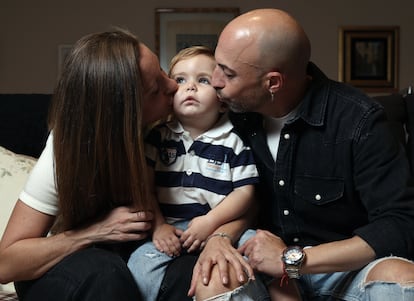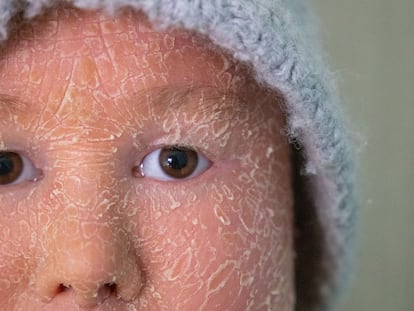The uncertainty of living with an extremely rare disease: ‘No one can tell us how it will evolve’
Guille is two years and eight months old. He lives with Desanto Shinawi Syndrome (DESSH), a rare pathology diagnosed in only about 100 people around the world

In all of Spain, there aren’t even a dozen people with the pathology that Guille suffers from. In fact, around the world, there are only around 100 people with the disorder.
Its discoverers called it Desanto Shinawi Syndrome (DESSH). Among the rare diseases, it’s one of the rarest. Most doctors don’t know about it. And, as often happens in these cases, the parents of children who suffer from it have to struggle to get a diagnosis and attain adequate care.
Treating a child with DESSH involves physiotherapy, as well as speech therapy. Guille needs the latter to stimulate his psychomotor development, which is far behind children his age. He’s two years and eight months old.
It all started with what seemed like a delay in growth when Guille was approaching the age of one. This is what several doctors diagnosed him with, at the Peace Hospital in Madrid. His mother, Laura, points out that her son rarely saw the same doctor more than once. This was despite the fact that when the neurologist (who ultimately diagnosed him with DESSH) treated Guille for the first time, he noticed it on the boy’s face, as soon as he saw him. “I don’t know what it is, but this child has a genetic syndrome,” said Dr. Alberto Fernández-Jaén, head of the department of Child Neurology at the Quirónsalud Madrid University Hospital.
What gave the condition away was — in addition to Guille’s small size — “his domed forehead, small nose, the shape of his ears, and his swollen hands and feet,” as his mother describes.
The characteristics of the syndrome are developmental delay, hypotonia, speech delay, mild to moderate intellectual disability, abnormal behavior and dimorphic facial features. Those who are used to working with children with these types of disorders can identify them quickly. Cristina Corral — the physiotherapist Laura went to — also detected a syndrome on the fly (without specifying which one) before she was able to give her definitive diagnosis.
However, as is the case with ailments that are so unusual, for other professionals, they tend to go unnoticed. This is the big problem with rare diseases: patients wait an average of four years to obtain a diagnosis and, in 20% of cases, 10 or more years pass, according to the Spanish Federation of Rare Diseases (FEDER). This waiting period means that time that could have gone towards treatments and rehabilitation is lost. These steps can decisively influence the life and development of the affected person.
Guille’s diagnosis, fortunately, didn’t take that long. When his parents realized they couldn’t figure out what was happening to their son, they went to Fernández-Jaén. The diagnosis came last May, when Guille was just over two-years-old. His parents had been uncertain for almost a year-and-a-half. “The tests cost 2,200 euros ($2,400), but it was clear that, even if I had to stop eating, I was going to do it to find out what was happening to my child,” Laura sighs. “He was already two-years-old and he didn’t say a word. He also suffered from constant episodes of bronchiolitis — he was breathing like a French bulldog. As a mother, I wondered how no one had noticed that something was wrong with him,” she laments.
When Guille was diagnosed with the syndrome, his parents looked everywhere for help, or for other parents to find support. They found nothing. The only place where the disease could be treated was in St. Louis, Missouri, where the doctors who discovered DESSH a little over a decade ago are based. In Spain, there are only about seven identified cases, while Fernández-Jaén estimates that there are no more than a hundred confirmed cases worldwide. However, the neurologist acknowledges that there may be more that haven’t been published in any scientific journal, while several more children may have not been properly diagnosed.
The doctor emphasizes the importance of detecting the disease as early as possible: “It’s vital, first of all, because you avoid unnecessary tests… [otherwise] the family ends up going on a pilgrimage between centers and specialists, which causes great suffering. Secondly, you can implement a specific stimulation and speech therapy program, because you know what issues are going to affect the child.”
Making progress
Since she started working with Guille last April, Corral — his physiotherapist — has seen him make enormous progress. “The [therapy] has focused on balance and respiratory problems,” she explains. “Today, Guille can move independently… something I wouldn’t have thought possible when we started before the summer.”
Corral — who specializes in neurological and respiratory physiotherapy — is used to dealing with parents who demand quick solutions. But Guille’s parents aren’t like that. “I prefer to propose what the worst case scenario could be. I knew that Guille was going to walk, but I didn’t know if he was going to be able to do it without support. I thought he would still require a walker, which, in the end, he didn’t need.” But not all children are as lucky as Guille, because not all parents can afford paying for a physiotherapist to come to the home. And, on top of the financial element, waiting lists for early care sometimes are years-long. “Your child’s health shouldn’t be conditioned by the economy,” Corral reflects.
Daniel de Vicente — from the FEDER’s board of directors — knows that it’s common for parents to end up resorting to private treatment and care. “Although there are more and more diagnostic means available in the public health system, they tend to be delayed. And this is costly, because the delays always result in a worsening of the pathology. Even in cases where there’s no treatment available, support can greatly improve the quality of life of the patient and their environment, on a physical and psychological level,” he explains.
Guille’s prognosis is hopeful. He walks and talks. “He says single words and many onomatopoeias of animal sounds, which he likes a lot; not phrases, not [what’s typical] for his age, but he’s progressing,” Laura says. His biggest challenge has to do with his cardiorespiratory system. This month, he’s already been hospitalized for a few days for bronchiolitis. “And no one can tell us how this may evolve, or if new problems will arise. We live with a lot of uncertainty. We won’t know anything if we don’t do more research,” Laura affirms.
Sign up for our weekly newsletter to get more English-language news coverage from EL PAÍS USA Edition
Tu suscripción se está usando en otro dispositivo
¿Quieres añadir otro usuario a tu suscripción?
Si continúas leyendo en este dispositivo, no se podrá leer en el otro.
FlechaTu suscripción se está usando en otro dispositivo y solo puedes acceder a EL PAÍS desde un dispositivo a la vez.
Si quieres compartir tu cuenta, cambia tu suscripción a la modalidad Premium, así podrás añadir otro usuario. Cada uno accederá con su propia cuenta de email, lo que os permitirá personalizar vuestra experiencia en EL PAÍS.
¿Tienes una suscripción de empresa? Accede aquí para contratar más cuentas.
En el caso de no saber quién está usando tu cuenta, te recomendamos cambiar tu contraseña aquí.
Si decides continuar compartiendo tu cuenta, este mensaje se mostrará en tu dispositivo y en el de la otra persona que está usando tu cuenta de forma indefinida, afectando a tu experiencia de lectura. Puedes consultar aquí los términos y condiciones de la suscripción digital.
More information
Últimas noticias
Most viewed
- Sinaloa Cartel war is taking its toll on Los Chapitos
- Oona Chaplin: ‘I told James Cameron that I was living in a treehouse and starting a permaculture project with a friend’
- Reinhard Genzel, Nobel laureate in physics: ‘One-minute videos will never give you the truth’
- Why the price of coffee has skyrocketed: from Brazilian plantations to specialty coffee houses
- Silver prices are going crazy: This is what’s fueling the rally










































